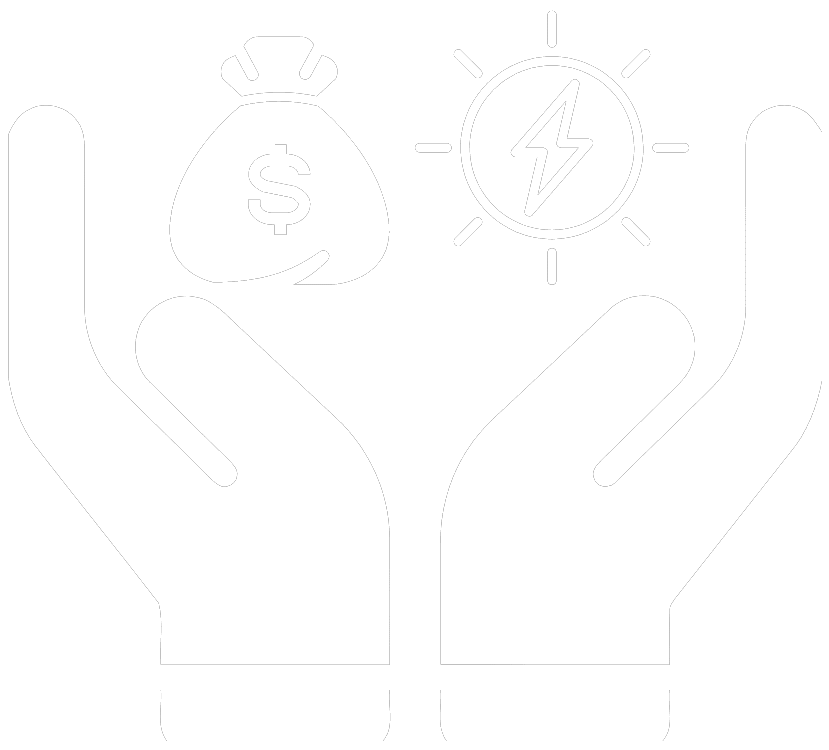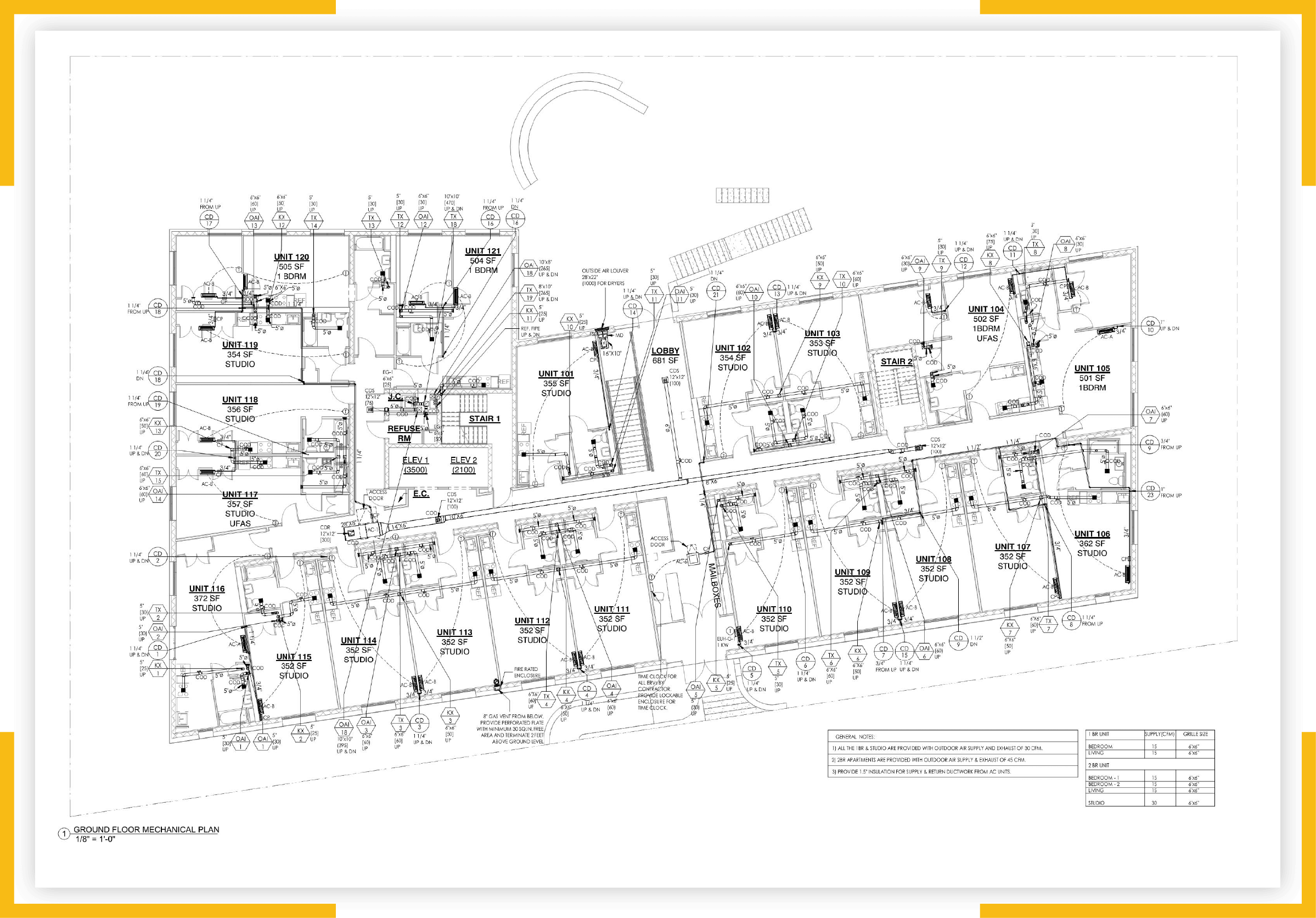Value Engineering & Peer Review
5 Days- That's a Lightning Fast Turnaround Time!
1
Upload Files and Pay
Upload PDF or CAD files, and pay to start the process. An engineer is auto-assigned to your project.
2
Document Review
An engineer will review all the documents shared and connect with you if anything else is required. Initial work starts.
3
Work Starts
Actual design/ report creation work begins.
4
Quality Check
The design and report are checked by the project manager to make sure 100% quality work is delivered.
5
Delivery
The design/ report is delivered to you.
NEED HELP OR ADDITIONALINFORMATION?
C A L L U S N O W
(646) 776-4010Get Your Value Engineering and Peer Review In 3 Easy Steps
0%
Get the error rectified drawings
0 Errors
IBC, IECC, states Code compliant Design
100%
Energy efficient design suggestions
Save cost and energy
Get residential/ commercial peer review within
5 Days
$ 1000
Value Engineering and Peer Review
Documents Required
MEP drawings in CAD or PDF format.
Delivery Time & Standards
We deliver your design (digitally) within 5 business days as per NYC DEP standards.
What's not Covered
This service does not cover site visits, stamping, DOB/DEP filing, and more than 2 minor iterations.
Service Constraint
The service fee covers MEP review for a maximum area of 3,000 sq. ft.
$1000*
Value Engineering & Peer Review


Get your residential/commercial peer review at lightning speed.


Get error-free drawings.


As per IBC, IECC states code-compliant design.


Energy efficient design suggestions.
Value Engineering and Peer Review
Comprehensive
We leave no stones unturned to uncover every potential opportunity of cost savings.
Disruption-Less
You don't need to compromise on aesthetic appeal. Our value engineering will include work only behind the walls.
Code Compliant
Assurity of error-free and local code compliant changes suggestions.


Our on-demand engineering expert
Still not sure about how to proceed?
YOU CAN WRITE TO ME AT inquiry@ny-engineers.com

New constructions and building renovations are major investments for development companies. When there are many potential projects, developers will want to focus on the most lucrative options. Value engineering (VE) consists of maximizing project functions and performance while optimizing costs, making it a very useful tool for investment decisions. The benefits of value engineering also apply for organizations who occupy the buildings they own, since it helps them achieve the lowest possible cost of ownership.
Peer review is the evaluation of work by professionals who have the same qualifications as those who produced the work. Peer review is very useful as a complement for value engineering, since it brings an external viewpoint to the project. This offers two key benefits: optimizing the project design, and bringing alternative solutions to the table. Even when a building project has a highly qualified engineering team, thinking outside the box can pose a challenge.
The combination of value engineering and peer review is considered a best practice in construction projects, since it helps maximize value. For investors and developers, this means the project becomes more lucrative. In general, there are two ways to increase value in projects:
- Achieving a higher performance without increasing costs.
- Achieving a lower cost without affecting performance.
Of course, the ideal scenario is when value engineering can increase performance while decreasing costs. In critical applications such as fire protection systems and structural design, value engineering can also be used to enhance safety while optimizing costs. VE can be applied in all technical fields that are involved in construction.
The cost of a new building or major renovation extends beyond the dollar amount in the project budget. Consider all the following costs, which are not reflected in construction cost estimates:
- Financing: Developers normally take loans for construction projects, which means paying interest to financial institutions. Financing can also be used to improve an existing building, with an energy retrofit or a similar upgrade. Even when project owners have enough capital to complete a project without financing, they often take loans to ease their cash flow. When VE is used to optimize project costs, it saves both capital and interest.
- Operation and Maintenance: Construction budgets only consider the cost of completing a building. However, buildings also have monthly operating expenses, and they require planned maintenance to stay in optimal conditions. Value engineering can also help reduce O&M costs.
- Engineering and Consulting: When a single company is in charge of design and construction, engineering costs are part of the contractor’s overhead. However, when different firms are in charge of design and construction, the project budget does not include the design cost.
- Other Professional Services: Project owners need the services of other professionals beyond architects and engineers. A building project also involves professionals like interior designers, lawyers, bankers and accountants.
- Emergencies: During its service life, a building can suffer damage due to accidents or natural disasters, and repairs are part of the ownership cost. Emergency costs are impossible to predict, but they can be mitigated with a resilient design.
- Insurance: The cost of building damage can be mitigated with a solid insurance plan, and building designs that improve safety are eligible for better plans. For example, insurance companies normally offer lower premiums when the fire protection design includes an automatic sprinkler system.
Contrary to popular belief, reducing construction costs is not the main purpose of value engineering. For instance, a lighting system with fluorescent and HID lamps is less expensive than an equivalent LED installation. However, LED lighting has a lower ownership cost when you consider its energy efficiency and simpler maintenance. Older lamp types consume more energy, while requiring more frequent replacements. Fluorescent and HID lighting are less expensive upfront, but LED lighting is less expensive in the long run.
In a few words, value engineering focuses on cost-effective design, and not low cost strictly speaking. The optimization process typically makes the project less expensive, but the main goal of VE is to maximize value. This means that VE may actually increase some project costs, as long as the benefit outweighs the added expense.

Value engineering achieves maximum benefits when applied early in the building process. Changing a preliminary design is simpler than changing final construction documents, and change orders during construction are much more expensive than design changes. The project owner and VE team can also accept suggestions from bidding contractors, but these must be included in the design documents before starting construction.
- Value engineering is much less effective in a project that has already started construction. At this point, the cost of major changes is likely higher than the benefit achieved.
- Some changes may still be cost-effective at this point, even if they involve rework. However, they will still increase the project budget, something that can be avoided by using value engineering from the start.
In theory, value engineering can be carried out by the project’s design team. However, this can be difficult because they must think outside the box, while judging their own work. Peer review brings an unbiased professional opinion, which is external and independent from the project. This generates more design options, allowing the best one to be chosen.
Value engineering and peer review can be combined with advanced design tools, achieving greater benefits. For example, if value engineering is applied during a building retrofit, it can be combined with energy modeling software. This allows value analysis for multiple scenarios, and the building owner can maximize the energy savings per dollar invested. Following a similar approach, NYC buildings subject to emissions limits (Local Law 97 of 2019) can maximize the emissions saved per dollar invested.
The Society of American Value Engineers (SAVE) breaks down the value engineering process into five steps, which are summarized in the following table:
|
Value Engineering Phase |
Description |
|
Information |
The VE team gathers information to get familiarized with the client’s requirements and the project. This step involves a functional analysis of the project as a whole, and also a separate analysis of its components. Based on project needs, the VE team identifies areas of high cost or low benefit. |
|
Speculation (Creative) |
The VE team uses brainstorming to generate a large number of potential solutions that can increase value. At this stage, the purpose is producing as many ideas as possible, without judging or rejecting any of them. |
|
Evaluation (Analysis) |
The potential solutions from the speculation phase are analyzed carefully, to select the ones that are feasible for the project in question. |
|
Development |
The ideas selected in the evaluation phase are developed in detail, to be applied in the project. These proposals include technical information and estimated costs. Also, their capital cost and life cycle cost are compared with the project baseline. |
|
Presentation |
As implied by its name, this phase consists of presenting the results of VE to the project owner and design team. The ideas are explained, and justified in terms of cost and benefit. |
Building performance is a very broad concept, since buildings have many systems and functions. Value engineering can be used to lower operation and maintenance expenses, improving cost performance. However, building performance can also refer to aspects like indoor comfort and environmental impact.
To apply value engineering, an important step is to determine the specific areas of building performance that will be improved. As an example, consider the performance categories of two rating systems for buildings: LEED and WELL.
|
Building Rating System |
Performance Areas |
|
WELL |
Air, water, nourishment, light, movement, thermal comfort, sound, materials, mind, community, innovation |
|
LEED |
Location & transportation, sustainable sites, water efficiency, energy and atmosphere, materials and resources, indoor environmental quality, innovation, regional priorities |
The WELL certification focuses on human wellbeing, while the LEED certification focuses on energy efficiency and environmental sustainability. These certifications are not mutually exclusive, and a building can achieve both. However, this an example of how “building performance” can have different meanings. Value engineering for a LEED certification will focus on different metrics than value engineering for a WELL certification.
Many building owners use value engineering to improve cost performance. In this case, the project design team and peer review team collaborate to determine the building design with the lowest ownership costs. Of course, there is a lower limit to how much costs can be reduced. The project must meet all applicable building codes, and cost reductions should not be at the expense of human well-being.
However, value engineering goes beyond cost optimization, since it can also improve the following aspects of building performance:
- Making the building safer for its occupants.
- Improving indoor air quality and thermal comfort.
- Reducing the carbon emissions produced by the building.
There is a common belief that additional building functions always increase costs. However, there are opportunities to improve performance while cutting costs. For example, smart ventilation controls can be combined with air pollution sensors to improve indoor air quality. This measure also saves energy by preventing overventilation - air handling systems are ramped down when their full capacity is not needed.
Value engineering can also be used to improve building safety at an optimal cost. For example, when designing an automatic sprinkler system, value engineering can be used to design a layout that achieves full coverage with the least sprinkler heads possible.
Building emissions are getting more priority with the growing concern about climate change and its potential consequences. In fact, New York City has already introduced building emissions limits that are legally mandated. In this case, value engineering can identify the measures that will maximize the emissions saved per dollar invested.

In building projects, there are cases where a design decision brings secondary benefits, such as improving the performance of another component or reducing its cost. For example, if all the electrical devices in a building are energy efficient, the installation uses less current. This reduces the design capacity and cost of many components:
- Electrical wiring
- Conduit and accessories
- Circuit breakers and other protections
- Main service equipment
The same logic applies for all building systems: a reduced workload also reduces the capacity and cost of many components. Water-saving plumbing fixtures will reduce piping costs and the required pump capacity, and an efficient building envelope will allow heating and cooling systems with a reduced nameplate capacity.
Value engineering considers the overall building performance and overall cost, instead of focusing on specific building features. This approach allows better design decisions, especially when VE is combined with peer review. VE is not exclusive for construction projects, and it can be applied before any investment decision.
Applying Value Engineering and Peer Review in Construction Projects

New constructions and building renovations are major investments for development companies. When there are many potential projects, developers will want to focus on the most lucrative options. Value engineering (VE) consists of maximizing project functions and performance while optimizing costs, making it a very useful tool for investment decisions. The benefits of value engineering also apply for organizations who occupy the buildings they own, since it helps them achieve the lowest possible cost of ownership.
Peer review is the evaluation of work by professionals who have the same qualifications as those who produced the work. Peer review is very useful as a complement for value engineering, since it brings an external viewpoint to the project. This offers two key benefits: optimizing the project design, and bringing alternative solutions to the table. Even when a building project has a highly qualified engineering team, thinking outside the box can pose a challenge.
The combination of value engineering and peer review is considered a best practice in construction projects, since it helps maximize value. For investors and developers, this means the project becomes more lucrative. In general, there are two ways to increase value in projects:
- Achieving a higher performance without increasing costs.
- Achieving a lower cost without affecting performance.
Of course, the ideal scenario is when value engineering can increase performance while decreasing costs. In critical applications such as fire protection systems and structural design, value engineering can also be used to enhance safety while optimizing costs. VE can be applied in all technical fields that are involved in construction.
Understanding the True Cost of a Project
The cost of a new building or major renovation extends beyond the dollar amount in the project budget. Consider all the following costs, which are not reflected in construction cost estimates:
- Financing: Developers normally take loans for construction projects, which means paying interest to financial institutions. Financing can also be used to improve an existing building, with an energy retrofit or a similar upgrade. Even when project owners have enough capital to complete a project without financing, they often take loans to ease their cash flow. When VE is used to optimize project costs, it saves both capital and interest.
- Operation and Maintenance: Construction budgets only consider the cost of completing a building. However, buildings also have monthly operating expenses, and they require planned maintenance to stay in optimal conditions. Value engineering can also help reduce O&M costs.
- Engineering and Consulting: When a single company is in charge of design and construction, engineering costs are part of the contractor’s overhead. However, when different firms are in charge of design and construction, the project budget does not include the design cost.
- Other Professional Services: Project owners need the services of other professionals beyond architects and engineers. A building project also involves professionals like interior designers, lawyers, bankers and accountants.
- Emergencies: During its service life, a building can suffer damage due to accidents or natural disasters, and repairs are part of the ownership cost. Emergency costs are impossible to predict, but they can be mitigated with a resilient design.
- Insurance: The cost of building damage can be mitigated with a solid insurance plan, and building designs that improve safety are eligible for better plans. For example, insurance companies normally offer lower premiums when the fire protection design includes an automatic sprinkler system.
Contrary to popular belief, reducing construction costs is not the main purpose of value engineering. For instance, a lighting system with fluorescent and HID lamps is less expensive than an equivalent LED installation. However, LED lighting has a lower ownership cost when you consider its energy efficiency and simpler maintenance. Older lamp types consume more energy, while requiring more frequent replacements. Fluorescent and HID lighting are less expensive upfront, but LED lighting is less expensive in the long run.
In a few words, value engineering focuses on cost-effective design, and not low cost strictly speaking. The optimization process typically makes the project less expensive, but the main goal of VE is to maximize value. This means that VE may actually increase some project costs, as long as the benefit outweighs the added expense.
Using Value Engineering Effectively

Value engineering achieves maximum benefits when applied early in the building process. Changing a preliminary design is simpler than changing final construction documents, and change orders during construction are much more expensive than design changes. The project owner and VE team can also accept suggestions from bidding contractors, but these must be included in the design documents before starting construction.
- Value engineering is much less effective in a project that has already started construction. At this point, the cost of major changes is likely higher than the benefit achieved.
- Some changes may still be cost-effective at this point, even if they involve rework. However, they will still increase the project budget, something that can be avoided by using value engineering from the start.
In theory, value engineering can be carried out by the project’s design team. However, this can be difficult because they must think outside the box, while judging their own work. Peer review brings an unbiased professional opinion, which is external and independent from the project. This generates more design options, allowing the best one to be chosen.
Value engineering and peer review can be combined with advanced design tools, achieving greater benefits. For example, if value engineering is applied during a building retrofit, it can be combined with energy modeling software. This allows value analysis for multiple scenarios, and the building owner can maximize the energy savings per dollar invested. Following a similar approach, NYC buildings subject to emissions limits (Local Law 97 of 2019) can maximize the emissions saved per dollar invested.
The Five Steps of Value Engineering
The Society of American Value Engineers (SAVE) breaks down the value engineering process into five steps, which are summarized in the following table:
|
Value Engineering Phase |
Description |
|
Information |
The VE team gathers information to get familiarized with the client’s requirements and the project. This step involves a functional analysis of the project as a whole, and also a separate analysis of its components. Based on project needs, the VE team identifies areas of high cost or low benefit. |
|
Speculation (Creative) |
The VE team uses brainstorming to generate a large number of potential solutions that can increase value. At this stage, the purpose is producing as many ideas as possible, without judging or rejecting any of them. |
|
Evaluation (Analysis) |
The potential solutions from the speculation phase are analyzed carefully, to select the ones that are feasible for the project in question. |
|
Development |
The ideas selected in the evaluation phase are developed in detail, to be applied in the project. These proposals include technical information and estimated costs. Also, their capital cost and life cycle cost are compared with the project baseline. |
|
Presentation |
As implied by its name, this phase consists of presenting the results of VE to the project owner and design team. The ideas are explained, and justified in terms of cost and benefit. |
Building Performance Areas that Benefit from Value Engineering
Building performance is a very broad concept, since buildings have many systems and functions. Value engineering can be used to lower operation and maintenance expenses, improving cost performance. However, building performance can also refer to aspects like indoor comfort and environmental impact.
To apply value engineering, an important step is to determine the specific areas of building performance that will be improved. As an example, consider the performance categories of two rating systems for buildings: LEED and WELL.
|
Building Rating System |
Performance Areas |
|
WELL |
Air, water, nourishment, light, movement, thermal comfort, sound, materials, mind, community, innovation |
|
LEED |
Location & transportation, sustainable sites, water efficiency, energy and atmosphere, materials and resources, indoor environmental quality, innovation, regional priorities |
The WELL certification focuses on human wellbeing, while the LEED certification focuses on energy efficiency and environmental sustainability. These certifications are not mutually exclusive, and a building can achieve both. However, this an example of how “building performance” can have different meanings. Value engineering for a LEED certification will focus on different metrics than value engineering for a WELL certification.
Many building owners use value engineering to improve cost performance. In this case, the project design team and peer review team collaborate to determine the building design with the lowest ownership costs. Of course, there is a lower limit to how much costs can be reduced. The project must meet all applicable building codes, and cost reductions should not be at the expense of human well-being.
However, value engineering goes beyond cost optimization, since it can also improve the following aspects of building performance:
- Making the building safer for its occupants.
- Improving indoor air quality and thermal comfort.
- Reducing the carbon emissions produced by the building.
There is a common belief that additional building functions always increase costs. However, there are opportunities to improve performance while cutting costs. For example, smart ventilation controls can be combined with air pollution sensors to improve indoor air quality. This measure also saves energy by preventing overventilation - air handling systems are ramped down when their full capacity is not needed.
Value engineering can also be used to improve building safety at an optimal cost. For example, when designing an automatic sprinkler system, value engineering can be used to design a layout that achieves full coverage with the least sprinkler heads possible.
Building emissions are getting more priority with the growing concern about climate change and its potential consequences. In fact, New York City has already introduced building emissions limits that are legally mandated. In this case, value engineering can identify the measures that will maximize the emissions saved per dollar invested.
Using Value Engineering to Find Synergy Among Design Features

In building projects, there are cases where a design decision brings secondary benefits, such as improving the performance of another component or reducing its cost. For example, if all the electrical devices in a building are energy efficient, the installation uses less current. This reduces the design capacity and cost of many components:
- Electrical wiring
- Conduit and accessories
- Circuit breakers and other protections
- Main service equipment
The same logic applies for all building systems: a reduced workload also reduces the capacity and cost of many components. Water-saving plumbing fixtures will reduce piping costs and the required pump capacity, and an efficient building envelope will allow heating and cooling systems with a reduced nameplate capacity.
Value engineering considers the overall building performance and overall cost, instead of focusing on specific building features. This approach allows better design decisions, especially when VE is combined with peer review. VE is not exclusive for construction projects, and it can be applied before any investment decision.


